Basic information about the shooting guard
General definition
The shooting guard is one of the five common basketball positions that generally emphasizes scoring points and/or demonstrating playmaking ability on offense while playing solid defense against the opposing team’s shooting guard, wing player, or other types of players, especially near perimeter areas of the court.
Abbreviation, number format, and alternative name
The shooting guard is sometimes abbreviated as SG, its position is usually indicated as the number 2 or 2-man, and its alternative name is typically referred to as off-guard.
Basic example diagram
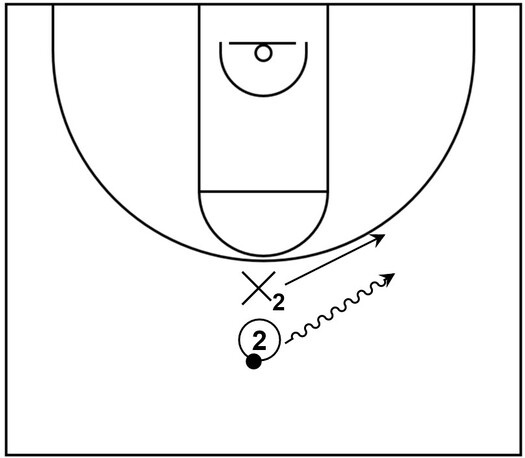
Here is a basic example diagram that simply shows the offensive and defensive shooting guard at the top area of the court, particularly during 1 on 1 action.
The offensive shooting guard is indicated by the number 2 while the defensive shooting guard is represented by the alphanumeric character X2.
The offensive shooting guard also has possession of the basketball, represented by the black dot.
For the example, 2 simply dribbles towards the right side of the court, indicated by the wavy arrow. As that occurs, X2 slides towards that same side of the floor, represented by the solid black arrow, to stay in front of 2.
Examples of potential offensive actions by the shooting guard
This section contains various examples of potential offensive actions such as basketball screens or basketball cuts that the shooting guard could be involved in.
Additionally, it should be noted that other offensive players beside the shooting guard on diagrams within the subsections below are typically represented by the standard basketball positions, unless otherwise noted.
To provide more clarity of this: 1 is the point guard; 3 is the small forward; 4 is the power forward; 5 is the center.
Backdoor cut from the wing
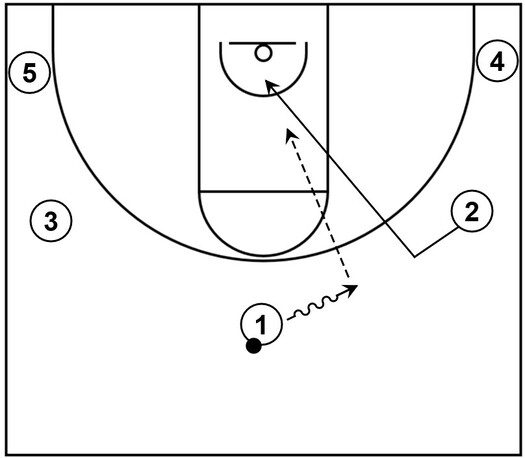
This example diagram features a shooting guard executing a backdoor cut from a wing area of the court.
To begin, 1 takes one dribble towards the right side wing, which is also a signal for 2 to perform a backdoor cut to the basket.
While still cutting to the basket, 2 receives the ball from 1 and scores by way of a layup at the rim.
Set cross screen into the lane
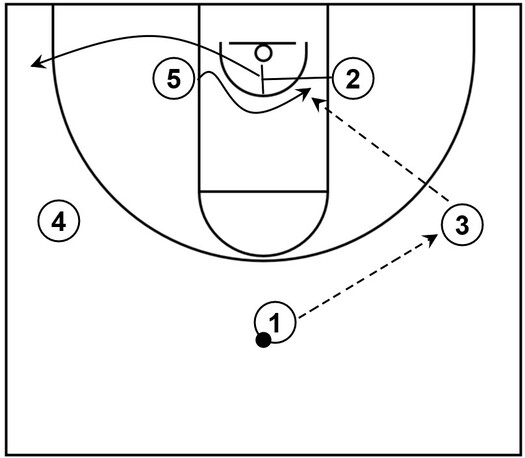
For this example, the shooting guard will set a cross screen to help a teammate get open near the basket.
Initially, 2 and 5 begin near the right side and left side low post areas while 1, 3, and 4 start at the top and wing areas respectively.
In terms of the offensive action, 3 receives the ball from 1. Afterwards, 2 steps into the lane to set a cross screen.
Next, 5 uses that screen to get open near the right side of the lane while 2 immediately sprints out to the left side corner.
From there, 5 could receive the ball from 3 and score via a layup.
Set cross screen and use down screen
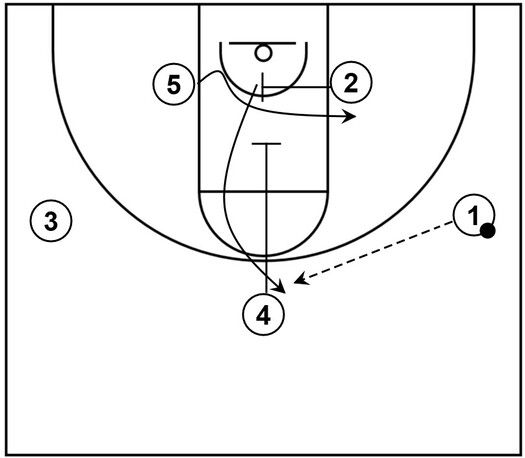
For this example, the shooting guard will set a cross screen for a teammate and then use a down screen that is set by another teammate.
This particular action is also known as screen the screener because one offensive player sets a screen and then uses a screen themselves.
In reference to the initial setup: 1 starts on the right side wing; 2 fills the right side low post area; 3 occupies the left side wing; 4 is at the top; 5 fills the left side low post area.
At the start of the action, 2 steps into the lane to set a cross screen. 5 uses that screen to get open near the right side low post area.
However, while that happens, 4 cuts toward the basket from the top to set a down screen in the lane. Afterwards, 2 uses that screen to get open near the top, effectively replacing the vacant spot previously held by 4.
Following that, 2 receives the ball from 1 and has the opportunity to take the three-point shot.
Iverson cut
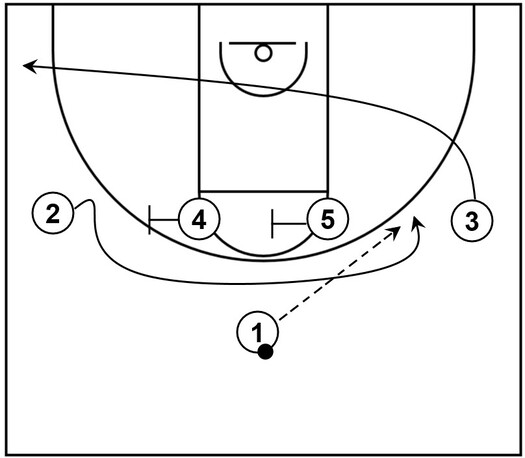
This example consists of a shooting guard using an Iverson cut to get open near a perimeter area of the court.
Additionally, the offensive team utilizes a 1-4 high setup that comprises the following: 1 at the top; 2 and 3 on the wings; 4 and 5 at the high post elbow areas.
As for the action itself, 3 cuts through to the left side corner while 2 executes an Iverson cut from the left side wing to the right side via a pair of high post screens set by 4 and 5.
Afterwards, 2 receives the ball from 1 and has the option to take the open three-point shot or possibly attack the rim to score points via a layup or other type of close-range shot.
Additional concepts and general summaries
General basketball moves to create possible scoring opportunities
Jab step
The jab step could be executed by the shooting guard in possession of the basketball to create space, generally by changing the on-ball defender’s stance.
As an example, let’s say that the shooting guard has possession of the ball and is currently in the triple threat position while being covered by an on-ball defender.
From there, the shooting guard could execute a half step to jab at the defender or away from the defender with their non-pivot foot. As a result of the jab step, the defender will usually react by changing their defensive stance.
In other words, the jab step would typically cause the defender to think that the shooting guard could possibly dribble towards the direction of the jab step.
Therefore, the defender will change their defensive stance in anticipation of the possible basketball move.
However, the shooting guard could then take advantage of that anticipation by simply taking a jump shot in the open space that was created after the jab step or dribbling the basketball in the opposite direction of the jab step to attack the rim.
Step back
The step back is a basketball move that could be executed by the shooting guard to create separation between themselves and the on-ball defender.
A simple way that the shooting guard could accomplish this is by initially attacking the basket with one or more dribbling moves. When that occurs, the on-ball defender will typically react by sliding laterally or backwards to stay in front of the ball.
From there, the shooting guard could use their inside foot that is closest to the basket to hop away from the on-ball defender. As a result, there would generally be at least a small amount of space between the shooting guard and the on-ball defender.
Following that, the shooting guard could use that window of opportunity to take a mid-range or three-point jump shot before the defense is able to counter via a defensive closeout and subsequent contest with a hand in the shooter’s face.
Crossover dribble
The crossover dribble consists of action that occurs when the shooting guard dribbles the basketball with one hand across their body and then catches it with the opposite hand, ultimately to generate scoring or playmaking opportunities.
The crossover dribble is another move that can help the shooting guard create space and separation by essentially misdirecting the on-ball defender towards one direction while the shooting guard actually dribbles toward the opposite direction.
Also, the crossover dribble could be highly effective during transition offense or any other time that the on-ball defender gives the shooting guard enough space to execute the dribble move.
Nevertheless, it should be mentioned that the crossover dribble is not as effective against an extremely aggressive on-ball defender.
Essentially, the shooting guard would not have enough space to perform the crossover dribble properly when a defender is crowding them too closely.
Moreover, even if the shooting guard does have just enough space to perform the crossover, it is generally better to be cautious when using it against an above average on-ball defender.
Essentially, an on-ball defender that is of a high level in terms of basketball IQ could potentially put their hand in the pathway of the crossover dribble, which is basically between the feet of the offensive player, in an attempt to knock the ball away.
If the high level on-ball defender does successfully get a hand on the ball during the crossover action, then that could possibly result in a steal for that defender and subsequent turnover for the shooting guard.
Between the legs dribble
Between the legs dribble consists of action that occurs when the shooting guard dribbles the basketball with one particular hand between their legs and afterwards, catches the ball with their opposite hand.
Somewhat similar to the crossover, between the legs dribble action could be beneficial in transition or when the on-ball defender gives an adequate amount of space to execute the move.
Also, between the legs dribble could be useful as a setup move and then linked with another type of dribble to form a combination move.
For example, let’s say that the shooting guard dribbles the ball between their legs a few times while remaining stationary in the same spot.
When that occurs, the on-ball defender might relax slightly in their defensive stance because the shooting guard is not going anywhere with the basketball at that current moment.
Immediately afterwards though, the shooting guard could then execute a crossover dribble and blow by the on-ball defender.
In other words, for that example scenario, the shooting guard utilized stationary between the legs dribble action to trick the on-ball defender into thinking that nothing important was going to happen.
However, once the on-ball defender loosens up their stance just a bit, the shooting guard attacks them with the crossover dribble to create separation.
It should also be noted though that between the legs dribble action, similar to the crossover, is typically not as potent against a very aggressive on-ball defender, primarily because it is not very likely that there would be enough space to execute the move effectively in that situation.
Behind the back dribble
Behind the back dribble consists of action that occurs when the shooting guard dribbles the basketball with one particular hand behind their back, as the name implies, and afterwards, catches the ball with their opposite hand.
Unlike the crossover or between the legs dribble, behind the back dribble action is actually more effective against aggressive on-ball defenders as it pertains to countering certain on-ball defensive actions.
For example, let’s say that the shooting guard is dribbling the ball towards the basket with their right hand. Furthermore, let’s also say that an on-ball defender attempts to aggressively cut off the driving lane towards the right side of the court.
When that occurs, the shooting guard could counter that defensive action with a right to left behind the back dribble move and then continue dribbling towards the basket with the left hand.
Moreover, the shooting guard would be able to create separation from the on-ball defender because as the defensive player initially cuts off the original pathway, their momentum would naturally carry them in that direction.
However, once the shooting guard dribbles it behind their back in the opposite direction, the momentum of the on-ball defender would not typically be able to change quickly enough, which creates the necessary separation.
As another example of how behind the back dribble action is good against aggressive defenders, let’s say that an on-ball defender is trying to steal the ball by constantly reaching in while the shooting guard dribbles it from their team’s backcourt towards the frontcourt.
To counter and essentially punish the pesky on-ball defender, the shooting guard could execute behind the back dribbling action as soon as the on-ball defender reaches for the ball.
When that occurs, the defensive player would automatically be out of proper stance from the reach-in action and at the same time, the shooting guard would create separation by dribbling in the opposite direction.
Hesitation dribble
The hesitation dribble comprises action that occurs when the shooting guard in possession of the ball initially dribbles it at least one time, which is then followed up by a delayed dribble, primarily to freeze a defender in their stance.
The hesitation dribble could also be utilized to create at least a small amount of separation from a defender prior to attacking the basket or executing a pull-up jump shot.
Furthermore, the hesitation dribble is versatile in that it could be useful against aggressive defenders or non-aggressive defenders.
For example, let’s say that an on-ball defender is implementing pressure against a shooting guard who is currently dribbling the basketball.
From there, to release the pressure, the shooting guard could execute the hesitation dribble to freeze the on-ball defender in their stance.
Immediately after the defender relaxes for a split second, the shooting guard could then utilize a speed dribble to blow by the defender and create separation.
As another example, let’s say that a shooting guard, initially in their team’s backcourt, is dribbling towards the basket during transition offense while a transition defender above the three-point line in the offensive team’s frontcourt begins backpedaling, ultimately to protect the basket.
When that occurs, the shooting guard could perform the hesitation dribble and cause the transition defender to delay or stop their backpedal action, if only for a moment.
Following that, the shooting guard could then execute a speed dribble to create separation and blow by the transition defender with the objective of scoring at the rim via a layup or dunk.
In and out dribble
The in and out dribble features action that occurs when the shooting guard dribbles the ball with one hand across the frontal area of their body while simultaneously executing a jab step with the opposite foot.
The in and out dribble could be very effective during transition offense as a defender backpedals to protect the basket.
The in and out dribble could also be useful against below average on-ball defenders who implement a poor defensive stance or against on-ball defenders who stand flat-footed.
Stutter step
The stutter step comprises action that happens when the shooting guard dribbles the ball while simultaneously executing a series of short and quick steps, primarily to attack the rim or take a jump shot.
The stutter step is best implemented against defenders who do not apply too much pressure such as backpedaling transition defenders, either in the offensive team’s backcourt or frontcourt area.
Moreover, the stutter step is generally effective because the short, quick steps could temporarily confuse the on-ball defender and cause them to freeze in their defensive stance, at least for a moment.
The stutter step could also be linked together with other moves to produce scoring or playmaking opportunities.
For example, a shooting guard in possession of the basketball could execute an initial stutter step move and follow that up with a crossover dribble to create separation from a defender.
From there, the shooting guard could then attack the rim, take a high quality jump shot, or possibly pass the ball to another teammate who is open near the basket or near one of the perimeter areas of the court, which could result in a potential assist as well.
Spin move
The spin move consists of action that occurs when the shooting guard in possession of the basketball typically dribbles it, and afterwards, turns their body 360 degrees, ultimately to create separation away from an adjacent on-ball defender.
The spin move could be effective against an aggressive on-ball defender who is trying to put pressure on the shooting guard.
Additionally, the spin move could be useful as a counter move against a defender who attempts to steal the ball by reaching in to poke the ball away.
For example, let’s say that a shooting guard has possession of the ball within their team’s backcourt and is initially dribbling it towards their team’s frontcourt.
However, let’s also say a certain defender aggressively moves toward the shooting guard and attempts to steal the ball.
When that happens, the shooting guard could counter that defensive aggression with a spin move.
As a result, the defender would be out of proper defensive position, which creates at least one defensive breakdown. The shooting guard would also be able to create a decent amount of separation as well.
It is also possible for the shooting guard to use a spin move, ultimately to create space to take a jump shot near perimeter areas of the court or to score near the basket with a close-range shot such as a layup or dunk.
What’s more, although the spin move is usually effective against aggressive defenders, it is generally ineffective against non-aggressive defenders that are not attempting to put immediate defensive pressure on the player in possession of the ball.
For example, let’s say that a transition defender is backpedaling to protect the basket during transition offense, and at the same time, a shooting guard with control of the ball is initially dribbling into their team’s frontcourt to attack the rim.
As that happens, if the shooting guard attempts a spin move against the retreating defender, it probably will not be beneficial as the defender would still be in proper defensive position following the spin move.
Put another way, if the shooting guard were to execute a spin move against the backpedaling defender, then that would not create a significant amount of separation, if any separation at all.
Half spin
The half spin is a variation of the spin move and it consists of action that happens when the shooting guard dribbles the ball, which is then followed by a 180 degree turn of the body, ultimately to create separation from an adjacent defender.
The half spin could be useful against an on-ball defender who anticipates the full spin move and attempts to cut it off by jumping in that direction.
Moreover, the half spin could also be utilized simply as a hesitation dribble to freeze a defender in their stance, at least momentarily.
In addition to that, similar to the spin move, the half spin is typically not as effective against a defender who is not implementing an adequate amount of pressure on the ball.
General summary of scoring points near the perimeter
The shooting guard typically scores points near the perimeter areas of the court by way of mid-range or three-point jump shots.
Also, it is usually recommended that the shooting guard should strive for high quality jump shots that are open and totally uncontested by defenders when possible.
To produce high quality jump shots, the shooting guard could consider utilizing one or more off-ball or on-ball screens.
Moreover, the shooting guard could also perform one or more basketball moves to create separation from the defender that would be covering them. After that, the shooting guard could take the jump shot at the moment when separation occurs.
General summary of scoring points near the basket
The shooting guard typically scores points near the basket by attacking the rim while in possession of the ball or by cutting to the rim as an off-ball player.
Also, in certain instances, the shooting guard could score near the basket via low post moves if they have the capability to do that as well, particularly within certain basketball offense strategies that feature that type of versatility such as the Swing offense.
Attack the rim
The shooting guard could utilize a quick first step to blow by their defender. From that point, the shooting guard could get to the rim and score before their defender could recover or before any helping defenders are able to limit or prevent the scoring opportunity.
Moreover, the first step is probably the simplest way to attack the rim as it generally only requires that the shooting guard is quicker than the on-ball defender. Also, the first step could be potentially effective if the on-ball defender makes a mistake such as being in an improper defensive stance.
In addition to that, the shooting guard could perform one or more basketball dribbling moves such as a crossover dribble or a between the legs dribble to break down the on-ball defender.
Following that, the shooting guard could attack the rim and score points.
What’s more, the shooting guard could make use of the on-ball screen and then score at the rim via a close-range shot such as a layup, dunk, or floater action.
Cut to the basket
If the shooting guard does not have possession of the ball, particularly while filling one of the perimeter areas of the court, it is still possible to score by simply cutting to the basket when the opportunity presents itself.
For example, let’s say that an offensive player such as the point guard has the ball near the right side wing and the shooting guard is currently located near the left side corner on the weak side of the court.
From there, let’s say that the point guard is able to dribble into the gaps of the defense, which also causes multiple defenders to collapse on the ball.
In other words, one or more defenders will slide into the lane to protect the basket and/or to prevent the point guard from scoring with the ball.
Let’s also say that the defender who is protecting the basket at that current time is not a typical shot blocker such as a rim-protecting center.
Instead, let’s say that the defender near the basket is somewhat of equal size or only slightly bigger than the shooting guard such as a small forward.
Alternatively, the defender could also be taller than the shooting guard such as a power forward but perhaps not as athletic in terms of vertical leaping ability.
Against those types of defenders, the shooting guard could immediately cut to the basket while the majority of the defense would be focusing on the point guard.
Afterwards, the shooting guard could receive the ball from the point guard, and then quickly score before the overall defense is able to fully react.
In this instance, cutting to the basket is useful because the shooting guard would be moving without the ball instead of standing still, which is easier for the defense to contain.
Furthermore, any time an off-ball player cuts to the basket, that action could potentially lead to defensive breakdowns because it is usually very difficult for the defense to cover the offensive player in possession of the basketball as well as any off-ball action effectively at the same time.
Although, it should be noted that if the primary defender near the basket did happen to be a rim-protector, then the shooting guard would probably want to stay near the left side corner and then receive the ball for a possible jump shot via a potential kick pass or drift pass from the point guard.